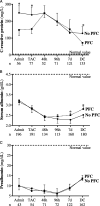Characterization of hypoalbuminemia following temporary abdominal closure
- PMID: 28837537
- PMCID: PMC5644021
- DOI: 10.1097/TA.0000000000001553
Characterization of hypoalbuminemia following temporary abdominal closure
Abstract
Background: The purpose of this study was to characterize associations among serum proteins, negative-pressure wound therapy (NPWT) fluid loss, and primary fascial closure (PFC) following emergent laparotomy and temporary abdominal closure (TAC). We hypothesized that high levels of C-reactive protein (CRP) and NPWT output would be associated with hypoalbuminemia and failure to achieve PFC.
Methods: We performed a retrospective analysis of 233 patients managed with NPWT TAC. Serum proteins and resuscitation indices were assessed on admission, initial laparotomy, and then at 48 hours, 96 hours, 7 days, and discharge. Correlations were assessed by Pearson coefficient. Multivariable regression was performed to identify predictors of PFC with cutoff values for continuous variables determined by Youden index.
Results: Patients who failed to achieve PFC (n = 55) had significantly higher CRP at admission (249 vs. 148 mg/L, p = 0.003), initial laparotomy (237 vs. 154, p = 0.002), and discharge (124 vs. 72, p = 0.003), as well as significantly lower serum albumin at 7 days (2.3 vs. 2.5 g/dL, p = 0.028) and discharge (2.5 vs. 2.8, p = 0.004). Prealbumin (in milligrams per deciliter) was similar between groups at each time point. There was an inverse correlation between nadir serum albumin and total milliliters of NPWT output (r = -0.33, p < 0.001). Exogenous albumin administration (in grams per day) correlated with higher serum albumin levels at each time point: 48 hours: r = 0.26 (p = 0.002), 96 hours: r = 0.29 (p = 0.002), 7 days: r = 0.40 (p < 0.001). Albumin of less than 2.6 g/dL was an independent predictor of failure to achieve PFC (odds ratio, 2.59; 95% confidence interval, 1.02-6.61) in a multivariate model including abdominal sepsis, body mass index of greater than 40 kg/m, and CRP of greater than 250 mg/L.
Conclusions: Early and persistent systemic inflammation and high NPWT output were associated with hypoalbuminemia, which was an independent predictor of failure to achieve PFC. The utility of exogenous albumin following TAC requires further study.
Level of evidence: Prognostic study, level III; Therapeutic study, level IV.
Conflict of interest statement
The authors declare no conflicts of interest.
Figures


Similar articles
-
Temporary abdominal closure for trauma and intra-abdominal sepsis: Different patients, different outcomes.J Trauma Acute Care Surg. 2017 Feb;82(2):345-350. doi: 10.1097/TA.0000000000001283. J Trauma Acute Care Surg. 2017. PMID: 27787442 Free PMC article.
-
Emergent laparotomy and temporary abdominal closure for the cirrhotic patient.J Surg Res. 2017 Apr;210:108-114. doi: 10.1016/j.jss.2016.11.013. Epub 2016 Nov 11. J Surg Res. 2017. PMID: 28457316 Free PMC article.
-
Hypertonic saline resuscitation after emergent laparotomy and temporary abdominal closure.J Trauma Acute Care Surg. 2018 Feb;84(2):350-357. doi: 10.1097/TA.0000000000001730. J Trauma Acute Care Surg. 2018. PMID: 29140948 Free PMC article.
-
The impact of standardized protocol implementation for surgical damage control and temporary abdominal closure after emergent laparotomy.J Trauma Acute Care Surg. 2019 Apr;86(4):670-678. doi: 10.1097/TA.0000000000002170. J Trauma Acute Care Surg. 2019. PMID: 30562327 Free PMC article.
-
The utilization of hypoalbuminemia as a prognostic metric in patients with spinal metastases: A scoping review.Brain Spine. 2025 Feb 25;5:104223. doi: 10.1016/j.bas.2025.104223. eCollection 2025. Brain Spine. 2025. PMID: 40103850 Free PMC article. Review.
Cited by
-
What is the most durable construct for a forefoot amputation, traditional transmetatarsal amputation or a medial ray sparing procedure?Ann Transl Med. 2019 Mar;7(Suppl 1):S47. doi: 10.21037/atm.2019.02.46. Ann Transl Med. 2019. PMID: 31032326 Free PMC article. No abstract available.
-
Difference between delayed anastomosis and early anastomosis in damage control laparotomy affecting the infusion volume and NPWT output volume: is infusion restriction necessary in delayed anastomosis? A single-center retrospective analysis.Trauma Surg Acute Care Open. 2022 Mar 8;7(1):e000860. doi: 10.1136/tsaco-2021-000860. eCollection 2022. Trauma Surg Acute Care Open. 2022. PMID: 35340705 Free PMC article.
References
-
- Hourigan LA, Linfoot JA, Chung KK, Dubick MA, Rivera RL, Jones JA, Salinas RD, Mann EA, Wade CE, Wolf SE, et al. Loss of protein, immunoglobulins, and electrolytes in exudates from negative pressure wound therapy. Nutr Clin Pract. 2010;25(5):510–516. - PubMed
-
- Vincent JL, de Backer D, Wiedermann CJ. Fluid management in sepsis: the potential beneficial effects of albumin. J Crit Care. 2016;35:161–167. - PubMed
-
- Parving HH, Hansen JM, Nielsen SL, Rossing N, Munck O, Lassen NA. Mechanisms of edema formation in myxedema—increased protein extravasation and relatively slow lymphatic drainage. N Engl J Med. 1979;301(9):460–465. - PubMed
-
- Dinarello CA. Interleukin-1 and the pathogenesis of the acute-phase response. N Engl J Med. 1984;311(22):1413–1418. - PubMed
Publication types
MeSH terms
Grants and funding
LinkOut - more resources
Full Text Sources
Other Literature Sources
Research Materials
Miscellaneous

